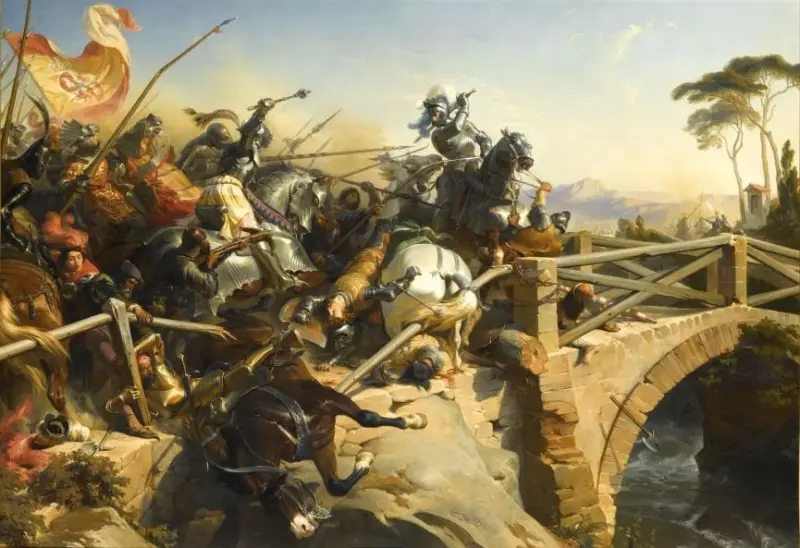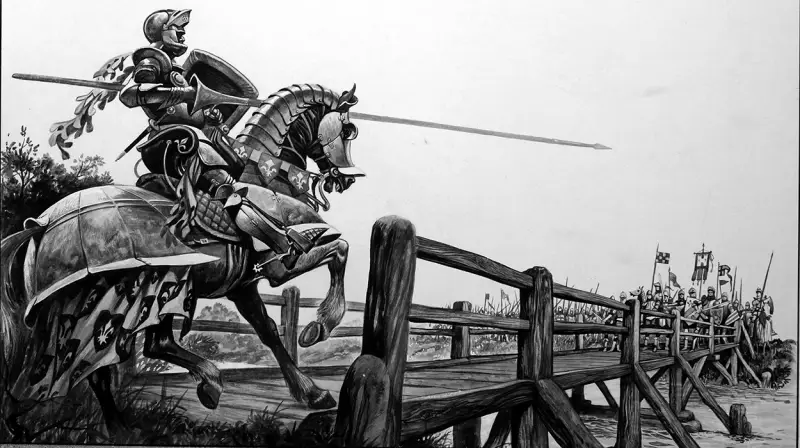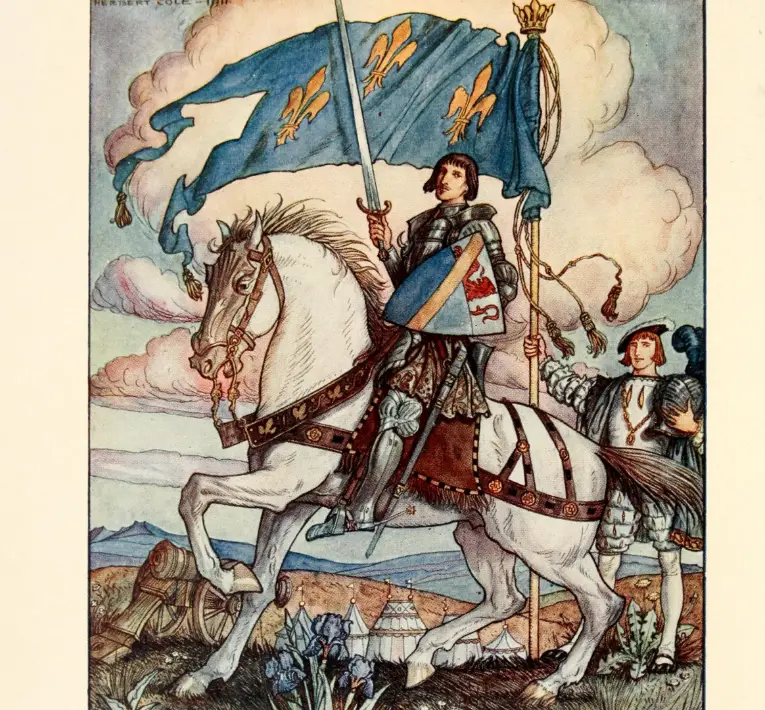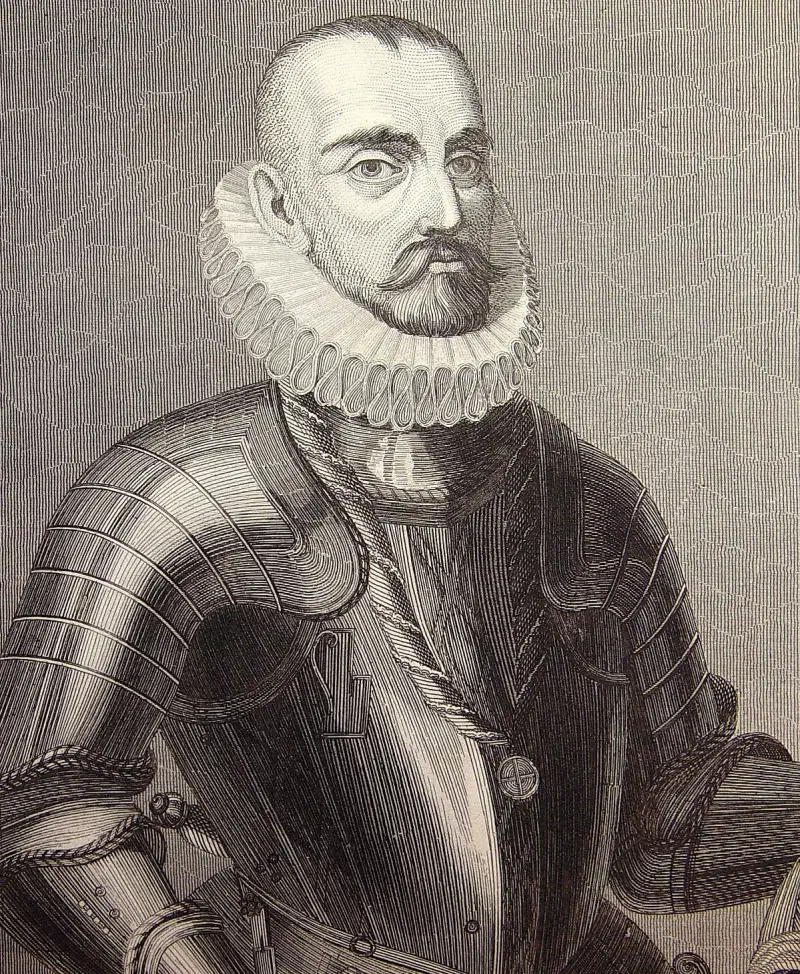The story of the duel between the famous knight Pierre Terray, Lord de Bayard and Lord Alonso de Soto Mayor

At the end of the XNUMXth - beginning of the XNUMXth centuries, in the era immediately preceding the appearance of duels, foot tournament battles came into fashion, in which completely non-knightly techniques were often used. weapon - halberds, two-handed swords, daggers and pikes.
Fights on the lists, where the actions of the participants were limited by strict rules and judicial supervision, were considered courtly fights - fights for pleasure and entertainment. Those knights who wanted to test themselves in an equal mortal battle looked for noble opponents for a fair fight in the enemy camp during the war [3].
Knights who received permission from their kings issued challenges and defended the honor of the chivalry of their kingdom with varying degrees of success. Sometimes the reason for such fights was the resolution of a conflict that arose during hostilities. For example, if a captive escaped, having given his word not to do this to the knight who captured him, or if a person released on parole for a ransom did not pay the amount that was agreed upon [3].
An example of just such a duel can be considered the duel between the famous French knight and commander Pierre Terray de Bayard, nicknamed by his contemporaries the knight without fear and reproach (as well as the “good knight”), and the Spanish lord Alonso de Soto Mayor.
Pierre Terray, Seigneur de Bayard: biographical milestones

Before we begin to consider the fight itself and its prerequisites, a few words should be said about its participants - Pierre Terray de Bayard and Alonso de Soto Mayor.
Pierre Terray, Seigneur Bayard, came from an old and noble Dauphiné family, rich not so much in worldly goods as in fame. Several of his ancestors held the relatively humble positions of guardians of castles and fortresses. Almost all of Bayard's ancestors died in poverty, but, as one author beautifully puts it, the inheritance was passed on from father to son on the battlefields [2].
Among Bayard's ancestors there were many outstanding personalities, for example, Bayard's uncle Pierre II died along with King Louis XI at the Battle of Montlhéry in 1465. However, as Etienne Paquier rightly noted:
The exact date of birth of the good knight is unknown. Symphorien Champier, according to the epitaph inscribed on his tomb, reports that he died in 1524 at the age of forty-eight years, which places his birth in 1476. And the historian de Terrebasse, based on studying some details of Bayard’s biography, comes to the conclusion that his date of birth should be considered 1473 [2].
Bayard was born in the castle of the same name in Dauphine in the south of France. He served for a time as a page to the young Duke Charles I of Savoy until March 1490, when the Duke died of illness. He later went into the service of King Charles VIII himself. In 1494, Bayard accompanied the expedition of Charles VIII to Italy with the aim of capturing the Kingdom of Naples. This campaign is known as the Italian War of 1494–1498. Bayard was knighted after the Battle of Fornovo in 1495, in which he captured the standard.
Among Bayard's many military exploits, it should be noted: the defense of the bridge over the Garigliano River at the Battle of Garigliano (1504), during which he fought with one hand (the other was wounded) against what is believed to be 200 Spanish soldiers; heroic participation in the siege of Padua (1509); defense for six weeks with a garrison of 1 soldiers of the city of Mezières besieged by the 000-strong army of Charles V in 35 (Charles V was forced to lift the siege and retreat).
Surrounded by fame during his lifetime, thanks to two biographers, Symphorien Champier and Jacques de Maillet, Bayard posthumously turned into a truly cult figure. In the portrait by Jacques de Maillet, his squire and biographer, Bayard appears as a man with a sharp and pale face, brown hair, a long nose and two attentive bright eyes.
Bayard was a tall man, confirmed by modern studies of his remains, which suggest that he stood 180 centimeters tall (5 ft 11 in), which was above the average height for his time. The French historian Aimard du Rivaille, a contemporary of Bayard, described him as a courteous and cheerful man; not arrogant, but modest.

As for the Spanish lord Don Alonso de Soto Mayor, who was a close relative of Gonzalo (Gonsalvo) Fernandez de Cordova*, a famous Spanish commander, and was the commander of the Spanish garrison in the city of Andria, little is known about him.
It was his duel with Senor Bayard that brought him fame (very dubious).

*Gonzalo Fernandez de Cordova is a famous Spanish commander and military reformer, nicknamed the “Great Captain.” Largely thanks to his outstanding victories, Spain in the 17th century became one of the most powerful military powers in Europe. He was knighted at age 1494 for outstanding bravery at the Battle of Las Hegas. He took part in the Catalan War of Isabella and Ferdinand of Arragon against Alfonso V. In XNUMX, at the head of the Spanish troops, he was sent to Italy to help the King of Naples Ferdinand II.
Background of the fight

In 1502, Pierre Terrail was appointed commander of the French garrison at the fortress of Minervino, located south of Andria. One fine day, while making a foray to the enemy cities of Andria and Barletta, the knights came across a group of Spanish squires led by Don Alonso de Soto Mayor, who decided to make a similar foray to the French fortress.
Seeing the red crosses, the good knight Pierre Terray de Bayard turned to his comrades [1]:
The battle lasted about half an hour, and the French managed to defeat the Spaniards. Seven Spaniards were killed, and the same number were captured. Among the prisoners was Don Alonso de Soto Mayor.
Don Alonso was taken along with other prisoners to the garrison, where, with his usual knightly politeness, Senor Bayard allocated him one of the best rooms of the castle, supplied him with everything necessary and gave him freedom of movement around the fortress, receiving the knight's word of honor that he would not attempt to escape [1]. The ransom was set at one thousand crowns.
However, Don Alonso broke his word - two weeks later he bribed one of the soldiers in the garrison and attempted to escape to Andria.
Since Don Alonso was allowed to come and go as he pleased, he rode through the gate without much difficulty and tried to escape. However, when Bayard, making his usual morning visit to the prisoner, did not find him anywhere, he sent in pursuit of him. Don Alonso was overtaken two miles from Andria, captured and again taken to the fortress [1].
The prisoner made excuses that he went to Andria only for his ransom, but after that Bayard could no longer trust Alonso and locked him in one of the castle towers. The ransom for Don Alonso was eventually received, and Bayard released him.
Since breaking a word in those days was a crime and was unworthy of a noble man, Alonso de Soto Mayor began to justify himself to his friends and associates by the fact that he was prompted to escape by ill-treatment by Bayard. Rumors spread by the former prisoner reached Pierre Terray, and he, in anger (since his honor was directly affected here), wrote a letter to Don Alonso, urging him to either retract his slanderous words, or accept the challenge to a mortal duel.
Duel of honor between Seigneur de Bayard and Don Alonso
The Spanish captain sent a bold reply, declaring that he would not retract anything he had said, and that he would prove his words in mortal combat within twelve days, two miles from the walls of Andria. Despite the fact that Bayard was sick with fever, he accepted the challenge [1].
When the day of the duel was set, Alonso asked the French knight the right to choose the weapon and type of duel. Bayard agreed to the Spaniard's demand.
Bayard's skill as a horseman and invincible fighter in lance fights was well known. Back when Bayard was a page to the Duke of Savoy, he received the nickname “Spearman” from King Charles VIII, whom Pierre Terrail amazed with his skill at the tournament in Leon in 1490. For this reason, Don Alonso proposed fighting on foot, choosing an estok (long stabbing sword) and a dagger as the weapons of the duel [3].
The duel took place on February 12, 1503. On the appointed day, Bayard, with his witness Bellabre and accompanied by many lords, went to the scene of the battle. Alonso soon arrived there with an equal number of Spanish nobles. He immediately sent Bayard two swords and two daggers to choose from. Bayard did not choose for long: he took what came to hand.
Afterwards, when all the usual rituals in such cases were observed, both opponents, having sworn allegiance as usual, entered the battlefield from opposite sides. Bayard had Bellabre as his witness, and La Palis as the umpire; Alonso had Don Quigones as a witness and Don Atanes as a judge [5].
The fight was short, but fierce - at the very beginning, Bayard wounded his opponent in the face, but the harmless wound only doubled Alonso’s ferocity. The French were afraid that Bayard would not be able to withstand a long fight due to illness, but their fears were in vain - despite his weakness, Bayard managed to inflict a fatal blow to the enemy in the neck with a sword.
Senor Bayard allowed the body of Don Alonso to be transferred to the Spaniards for an honorable burial.
- these were the words knight Pierre Terray de Bayard said to one of the witnesses on Don Alonso’s side.
Использованная литература:
[1]. Hare Christopher. The story of Bayard: the good knight without fear and without reproach. New York, 1911.
[2]. Par Guyard de Berville. Histoire de Pierre Terrail, dit le chevalier Bayard, sans peur et reproche. – Lyon: Bernuset, 1786.
[3]. Novoselov V. R. The last argument of honor. Duel in France in the 2005th – early XNUMXth centuries. – St. Petersburg, Atlant, XNUMX.
[4]. Etienne Paquier, Recherches sur la France, ch. XX.
[5]. Roy J. J. Michaud J. F. History chivalry / Juste Jean Roy, Joseph Francois Michaud; thin G. Dore et al. - M.: Eksmo, 2007.
Information